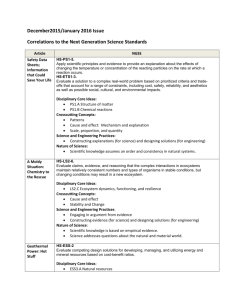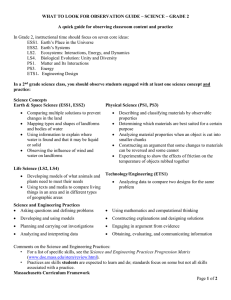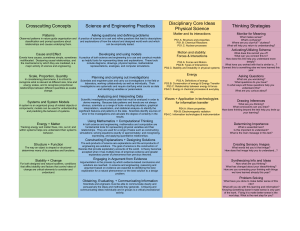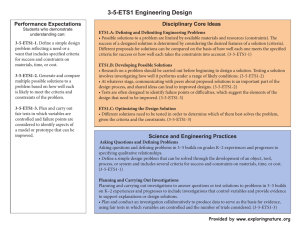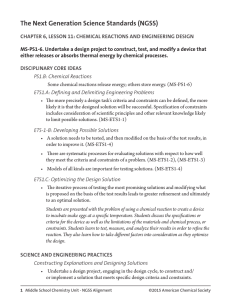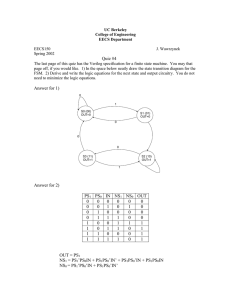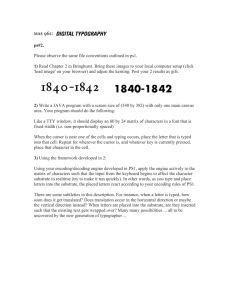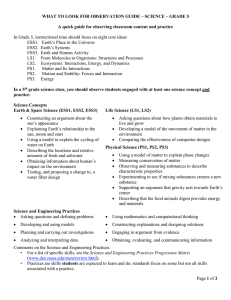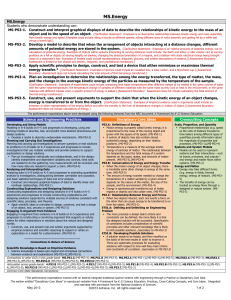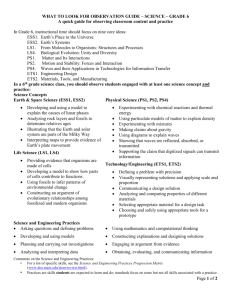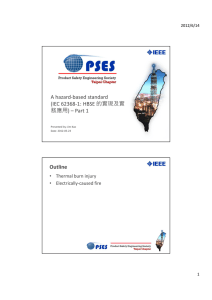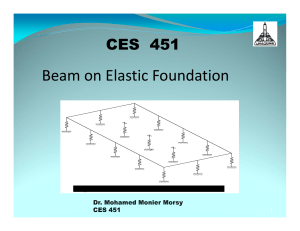The Core of Chemistry: Connections to the NGSS
advertisement
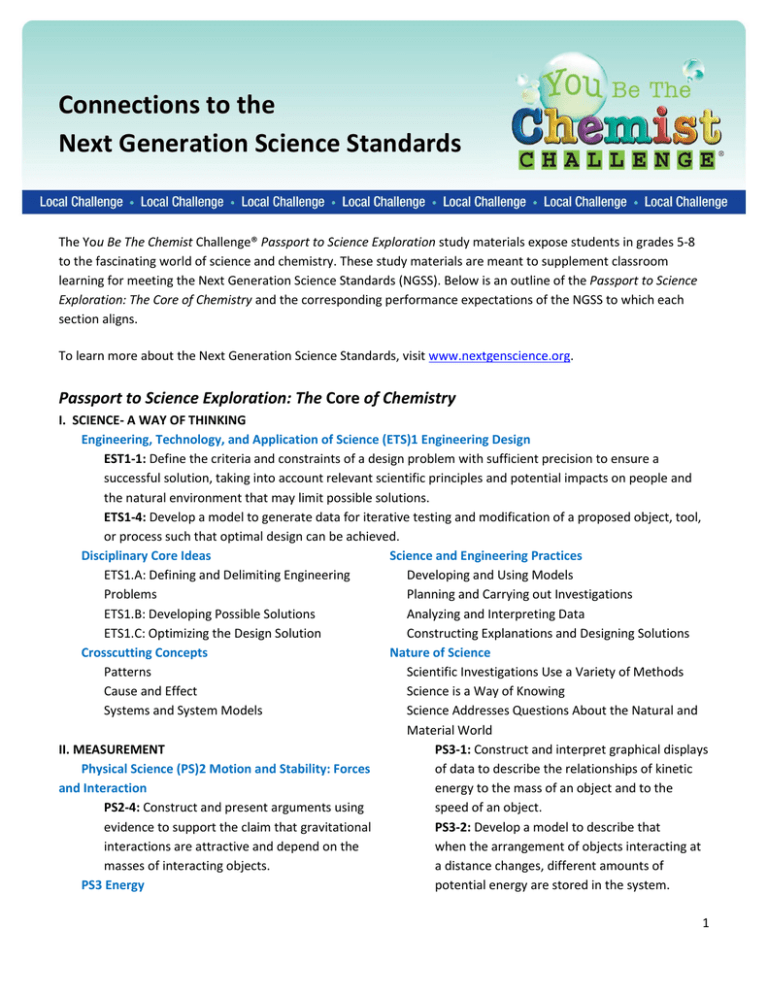
Connections to the Next Generation Science Standards The You Be The Chemist Challenge® Passport to Science Exploration study materials expose students in grades 5-8 to the fascinating world of science and chemistry. These study materials are meant to supplement classroom learning for meeting the Next Generation Science Standards (NGSS). Below is an outline of the Passport to Science Exploration: The Core of Chemistry and the corresponding performance expectations of the NGSS to which each section aligns. To learn more about the Next Generation Science Standards, visit www.nextgenscience.org. Passport to Science Exploration: The Core of Chemistry I. SCIENCE- A WAY OF THINKING Engineering, Technology, and Application of Science (ETS)1 Engineering Design EST1-1: Define the criteria and constraints of a design problem with sufficient precision to ensure a successful solution, taking into account relevant scientific principles and potential impacts on people and the natural environment that may limit possible solutions. ETS1-4: Develop a model to generate data for iterative testing and modification of a proposed object, tool, or process such that optimal design can be achieved. Disciplinary Core Ideas Science and Engineering Practices ETS1.A: Defining and Delimiting Engineering Developing and Using Models Problems Planning and Carrying out Investigations ETS1.B: Developing Possible Solutions Analyzing and Interpreting Data ETS1.C: Optimizing the Design Solution Constructing Explanations and Designing Solutions Crosscutting Concepts Nature of Science Patterns Scientific Investigations Use a Variety of Methods Cause and Effect Science is a Way of Knowing Systems and System Models Science Addresses Questions About the Natural and Material World II. MEASUREMENT PS3-1: Construct and interpret graphical displays Physical Science (PS)2 Motion and Stability: Forces of data to describe the relationships of kinetic and Interaction energy to the mass of an object and to the PS2-4: Construct and present arguments using speed of an object. evidence to support the claim that gravitational PS3-2: Develop a model to describe that interactions are attractive and depend on the when the arrangement of objects interacting at masses of interacting objects. a distance changes, different amounts of PS3 Energy potential energy are stored in the system. 1 Disciplinary Core Ideas PS1.A: Structure and Properties of Matter PS3.A: Definitions of Energy ETS1.A: Defining and Delimiting Engineering Problems Crosscutting Concepts Patterns Scale, Proportion, and Quantity Science and Engineering Practices Asking Questions and Defining Problems Using mathematics and computational thinking Nature of Science Scientific Knowledge Assumes an Order and Consistency in Natural Systems Science Addresses Questions About the Natural and Material World III. CLASSIFICATION OF MATTER PS1 Matter and Its Interactions PS1-1: Develop models to describe the atomic composition of simple molecules and extended structures. PS1-2: Analyze and interpret data on the properties of substances before and after the substances interact to determine if a chemical reaction has occurred. PS1-3: Develop a model that predicts and describes changes in particle motion, temperature, and state of a pure substance when thermal energy is added or removed. PS3 Energy PS3-1: Construct and interpret graphical displays of data to describe the relationships of kinetic energy to the mass of an object and to the speed of an object. PS3-2: Develop a model to describe that when the arrangement of objects interacting at a distance changes, different amounts of potential energy are stored in the system. Disciplinary Core Ideas Science and Engineering Practices PS1.A: Structure and Properties of Matter Asking Questions and Defining Problems PS1.B: Chemical Reactions Using Mathematics and Computational Thinking PS3.A: Definitions of Energy Nature of Science PS3.B: Conservation of Energy and Energy Scientific Investigations Use a Variety of Methods Transfer Scientific Knowledge is Based on Empirical Evidence Crosscutting Concepts Scientific Models, Laws, Mechanisms, and Theories Systems and Models Explain Natural Phenomena Energy and Matter Structure and Function Stability and Change IV. ATOMIC STRUCTURE PS1 Matter and Its Interactions PS1-1: Develop models to describe the atomic composition of simple molecules and extended structures. Disciplinary Core Ideas Science and Engineering Practices PS1.A: Structure and Properties of Matter Developing and using models Crosscutting Concepts Using Mathematics and Computational Thinking Patterns Constructing Explanations and Designing Solutions Systems and Models Nature of Science Structure and Function Scientific Knowledge Assumes an Order and Consistency in Natural Systems 2 V. THE PERIODIC TABLE PS1 Matter and Its Interactions PS1-1: Develop models to describe the atomic composition of simple molecules and extended structures. Disciplinary Core Ideas Science and Engineering Practices PS1.A: Structure and Properties of Matter Developing and using models Crosscutting Concepts Using Mathematics and Computational Thinking Patterns Constructing Explanations and Designing Solutions Systems and Models Nature of Science Energy and Matter Scientific Knowledge is Open to Revision in Light of Structure and Function New Evidence Scientific Models, Laws, Mechanisms, and Theories Explain Natural Phenomena VI & VII. LABORATORY EQUIPMENT & LABORATORY AND CHEMICAL SAFETY Science and Engineering Practices Planning and Carrying out Investigations Analyzing and Interpreting Data Obtaining, Evaluating, and Communicating Information Constructing Explanations and Designing Solutions Obtaining, Evaluating, and Communicating Information Nature of Science Scientific Investigations Use a Variety of Methods Scientific Knowledge is Based on Empirical Evidence Science is a Way of Knowing Science is a Human Endeavor 3
